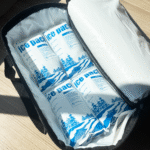What Are the Maximum Allowed Quantities of Dry Ice Per Package? A Complete Guide
Shipping dry ice requires understanding the rules governing its transportation to ensure safety and compliance. Dry ice, or solid CO2, is vital for shipping temperature-sensitive goods, but its hazardous nature imposes strict regulations on how much can be shipped per package. In 2025, these limits vary depending on the transportation mode. This guide will walk you through the maximum quantities allowed, packaging requirements, and more.
-
Air Transport Limits: 2.5 kg for passenger flights, 200 kg for cargo flights.
-
Ground Transport: Up to 200 kg, with fewer restrictions on ventilation and packaging.
-
International Shipments: Vary by country; always check the destination’s regulations.
-
Packaging Requirements: Ventilation is critical to prevent CO₂ buildup.
What Are the Maximum Limits for Dry Ice in Air Transport?
Air Transport and Dry Ice Regulations
For air transport, strict regulations control the amount of dry ice per package due to the risks associated with CO₂ gas buildup in confined spaces.
-
Passenger Flights: Maximum of 2.5 kg (5.5 lb) per package.
-
Cargo Flights: Allowed up to 200 kg (440 lb), though this can vary depending on the airline.
These limits are imposed to prevent asphyxiation risks from the sublimation of dry ice, which releases CO₂ gas. Airlines and cargo carriers require packages to be vented and clearly labeled with the weight and “Dry Ice” hazard symbol.
Key Insight: Always check with your airline or freight provider, as additional restrictions might apply depending on the aircraft type.
Packaging Requirements
Dry ice packages must allow gas to escape to prevent pressure buildup. The packaging must be vented, and it should be labeled with “Dry Ice,” the net weight, and the hazard symbol “UN 1845”. Airlines typically reject unvented packages due to safety concerns.
| Shipping Mode | Max Dry Ice | Packaging Requirements | Why It Matters |
|---|---|---|---|
| Passenger Flights | 2.5 kg | Vented containers, labeled “Dry Ice” | Safety, asphyxiation risk prevention |
| Cargo Flights | 200 kg | Vented, labeled, proper documentation | Larger spaces, controlled environments |
| Ground Transport | 200 kg | Vented packaging, hazard labels | Reduces CO₂ buildup risk in confined spaces |
| International Shipments | Varies | Check country-specific regulations | Compliance with local laws and regulations |
How Much Dry Ice Can You Ship by Ground and Sea Transport?
Ground Transport Regulations
For ground shipments, such as personal or commercial vehicles, the regulations are more relaxed than for air transport. According to the Department of Transportation (DOT), you can ship up to 200 kg per package. However, adequate ventilation is still necessary.
Sea Transport Regulations
Sea freight often mirrors air transport regulations, especially under the International Maritime Dangerous Goods (IMDG) Code. Packages can be larger, but proper labeling, venting, and documentation are still required to prevent CO₂ hazards during longer transit periods.
Special Considerations for Dry Ice Shipping
International Shipments
When shipping internationally, it’s essential to be aware of the varying regulations across different countries. Some regions may have stricter limits or specific documentation requirements, so always consult with your carrier before shipping internationally.
Exceptions and Special Provisions
Certain exceptions exist for larger quantities of dry ice under special circumstances. For instance, cargo aircraft may accept more than 200 kg per package if the shipment is properly packaged and labeled according to specific regulations.
How to Safely Package Dry Ice
Proper packaging of dry ice is crucial to avoid accidents such as container ruptures due to CO₂ pressure buildup. Always use sturdy, leak-proof containers with vent holes or cracked lids.
Packaging Checklist:
-
Containers: Use rigid boxes made from fiberboard, plastic, or wood.
-
Ventilation: Ensure the container allows CO₂ gas to escape.
-
Insulation: Use foam, but leave gaps for gas release to prevent airtight seals.
-
Labeling: Clearly mark the package with “Dry Ice” and include the weight and hazard labels.
FAQ: Common Dry Ice Shipping Questions
Q1: How much dry ice can I carry on a plane?
Passengers can carry 2.5 kg (5.5 lb) of dry ice in checked or carry-on luggage, with the airline’s approval and proper venting.
Q2: Can I ship more than 200 kg of dry ice?
Yes, but you’ll need special provisions, like larger cargo shipments with prior carrier approval. Check with the carrier for compliance.
Q3: What happens if I exceed the dry ice limits?
Exceeding the limits can lead to delays, fines, or rejection of the shipment by the carrier. Always verify the limits with your transport provider.
Conclusion: Key Takeaways
Shipping dry ice requires strict adherence to regulatory limits to ensure safety. Whether you’re transporting by air, ground, or sea, understanding and complying with the maximum dry ice quantities per package is vital to avoid penalties. Always use vented packaging, ensure proper labeling, and check the latest regulations.
Actionable Advice: Ready to ship safely? Contact us for expert advice on packaging, compliance, and choosing the right transport mode for your dry ice shipments.
About Tempk
Tempk is a leader in cold-chain logistics, providing innovative packaging solutions and regulatory compliance support for dry ice shipping. Our team ensures your temperature-sensitive shipments comply with all transport regulations.
























